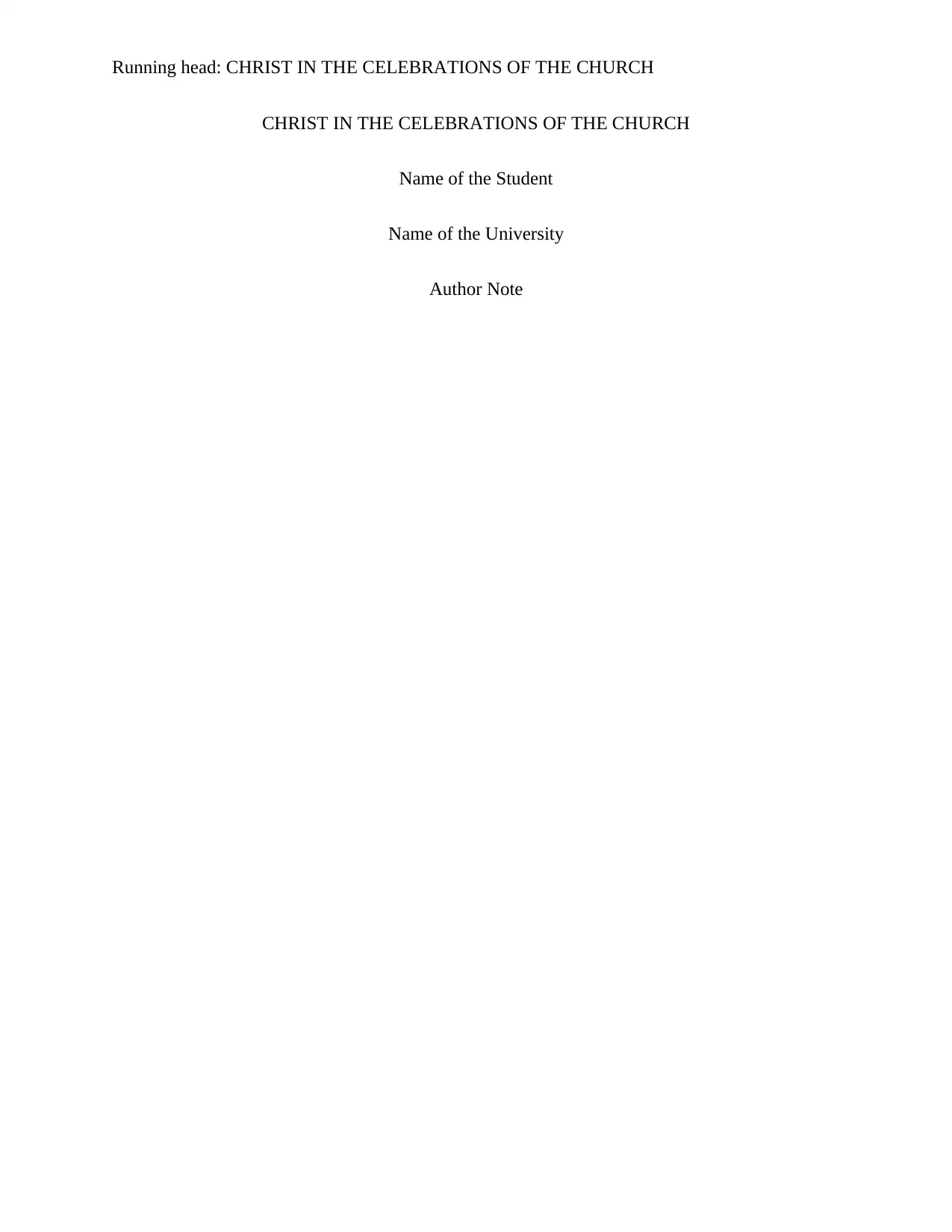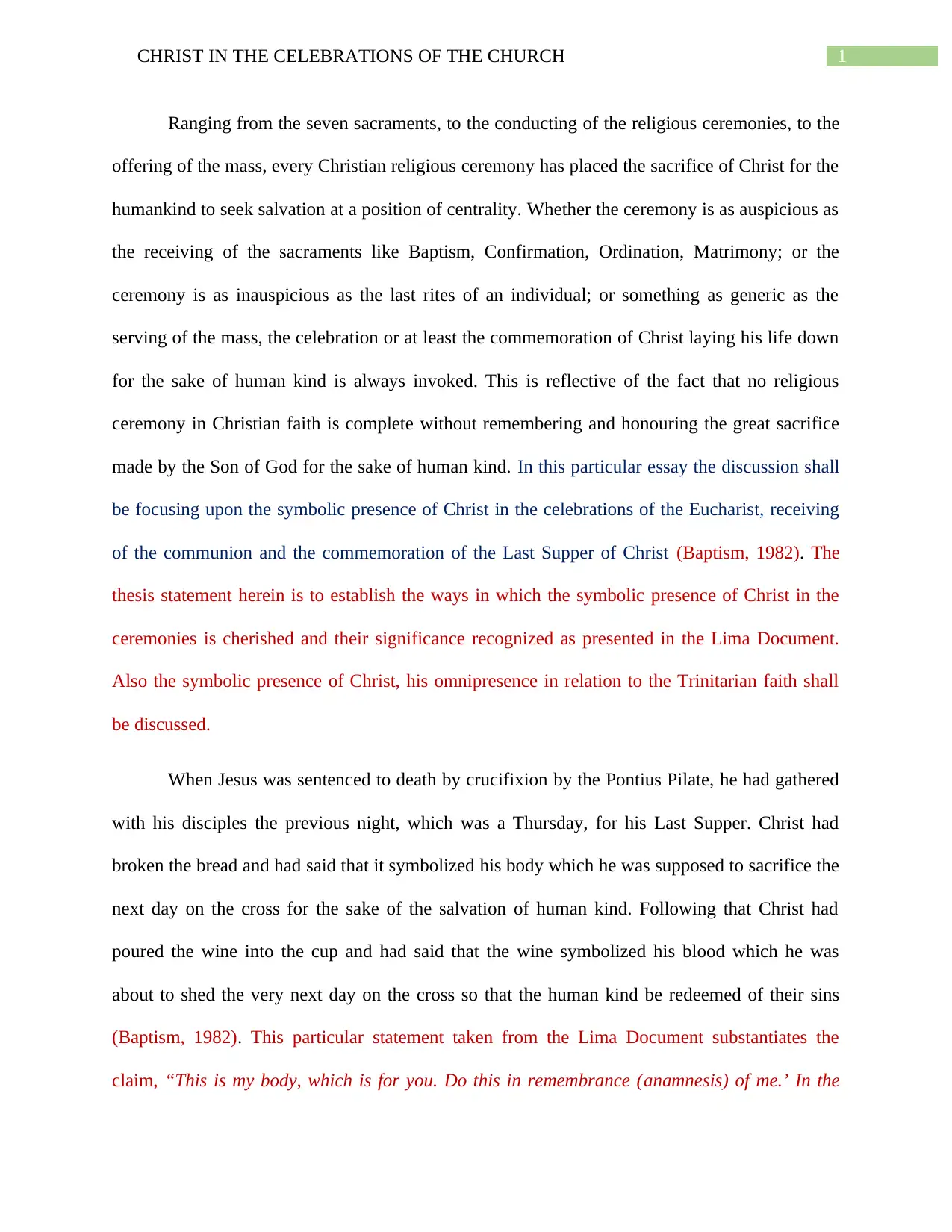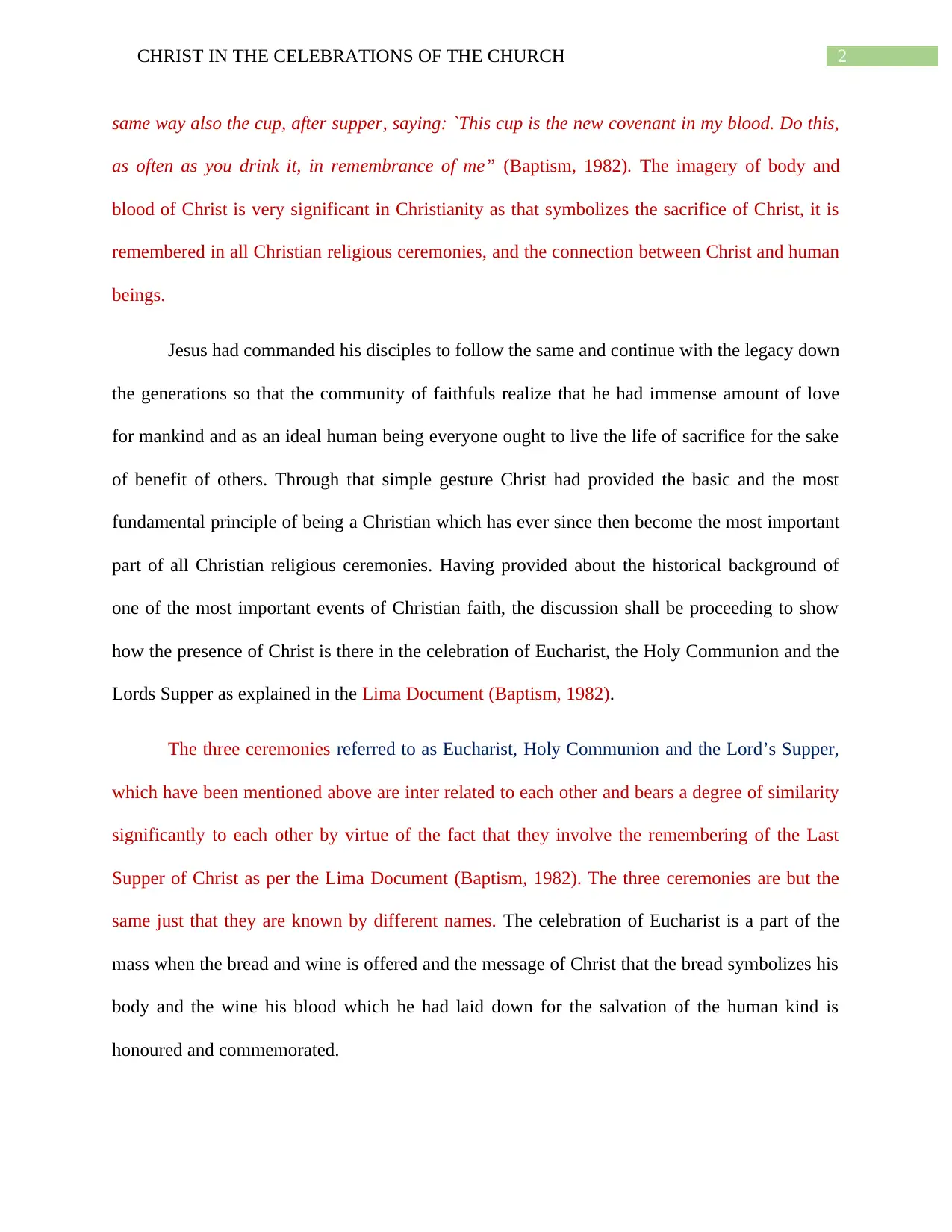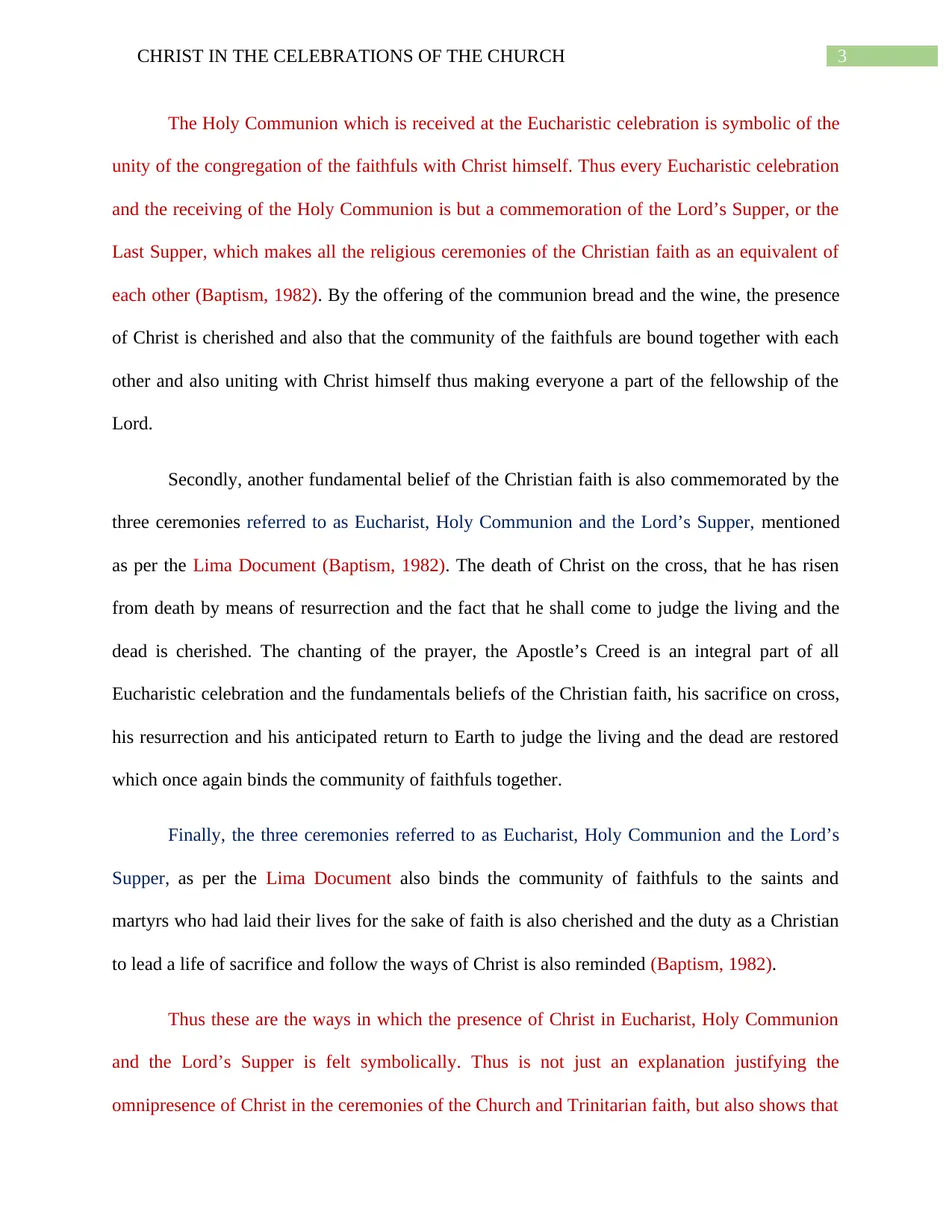Christ in the Celebrations of the Church: A Symbolic Analysis
VerifiedAdded on 2023/04/25
|6
|1260
|74
Essay
AI Summary
This essay delves into the symbolic presence of Christ within Christian celebrations, particularly focusing on the Eucharist, Holy Communion, and the Lord's Supper as understood through the Lima Document. It highlights how these ceremonies commemorate Christ's sacrifice, his resurrection, and the anticipation of his return, emphasizing the significance of the Last Supper. The essay explains that the Eucharist and Holy Communion are central to Christian faith, symbolizing the unity of the faithful with Christ and each other. Furthermore, it elucidates how these rituals reinforce core Christian beliefs, including Christ's death, resurrection, and future judgment, while also honoring saints and martyrs. Ultimately, the essay argues that the symbolic presence of Christ in these ceremonies underscores the importance of living a life of sacrifice and following the teachings of Christ.

Running head: CHRIST IN THE CELEBRATIONS OF THE CHURCH
CHRIST IN THE CELEBRATIONS OF THE CHURCH
Name of the Student
Name of the University
Author Note
CHRIST IN THE CELEBRATIONS OF THE CHURCH
Name of the Student
Name of the University
Author Note
Paraphrase This Document
Need a fresh take? Get an instant paraphrase of this document with our AI Paraphraser

1CHRIST IN THE CELEBRATIONS OF THE CHURCH
Ranging from the seven sacraments, to the conducting of the religious ceremonies, to the
offering of the mass, every Christian religious ceremony has placed the sacrifice of Christ for the
humankind to seek salvation at a position of centrality. Whether the ceremony is as auspicious as
the receiving of the sacraments like Baptism, Confirmation, Ordination, Matrimony; or the
ceremony is as inauspicious as the last rites of an individual; or something as generic as the
serving of the mass, the celebration or at least the commemoration of Christ laying his life down
for the sake of human kind is always invoked. This is reflective of the fact that no religious
ceremony in Christian faith is complete without remembering and honouring the great sacrifice
made by the Son of God for the sake of human kind. In this particular essay the discussion shall
be focusing upon the symbolic presence of Christ in the celebrations of the Eucharist, receiving
of the communion and the commemoration of the Last Supper of Christ (Baptism, 1982). The
thesis statement herein is to establish the ways in which the symbolic presence of Christ in the
ceremonies is cherished and their significance recognized as presented in the Lima Document.
Also the symbolic presence of Christ, his omnipresence in relation to the Trinitarian faith shall
be discussed.
When Jesus was sentenced to death by crucifixion by the Pontius Pilate, he had gathered
with his disciples the previous night, which was a Thursday, for his Last Supper. Christ had
broken the bread and had said that it symbolized his body which he was supposed to sacrifice the
next day on the cross for the sake of the salvation of human kind. Following that Christ had
poured the wine into the cup and had said that the wine symbolized his blood which he was
about to shed the very next day on the cross so that the human kind be redeemed of their sins
(Baptism, 1982). This particular statement taken from the Lima Document substantiates the
claim, “This is my body, which is for you. Do this in remembrance (anamnesis) of me.’ In the
Ranging from the seven sacraments, to the conducting of the religious ceremonies, to the
offering of the mass, every Christian religious ceremony has placed the sacrifice of Christ for the
humankind to seek salvation at a position of centrality. Whether the ceremony is as auspicious as
the receiving of the sacraments like Baptism, Confirmation, Ordination, Matrimony; or the
ceremony is as inauspicious as the last rites of an individual; or something as generic as the
serving of the mass, the celebration or at least the commemoration of Christ laying his life down
for the sake of human kind is always invoked. This is reflective of the fact that no religious
ceremony in Christian faith is complete without remembering and honouring the great sacrifice
made by the Son of God for the sake of human kind. In this particular essay the discussion shall
be focusing upon the symbolic presence of Christ in the celebrations of the Eucharist, receiving
of the communion and the commemoration of the Last Supper of Christ (Baptism, 1982). The
thesis statement herein is to establish the ways in which the symbolic presence of Christ in the
ceremonies is cherished and their significance recognized as presented in the Lima Document.
Also the symbolic presence of Christ, his omnipresence in relation to the Trinitarian faith shall
be discussed.
When Jesus was sentenced to death by crucifixion by the Pontius Pilate, he had gathered
with his disciples the previous night, which was a Thursday, for his Last Supper. Christ had
broken the bread and had said that it symbolized his body which he was supposed to sacrifice the
next day on the cross for the sake of the salvation of human kind. Following that Christ had
poured the wine into the cup and had said that the wine symbolized his blood which he was
about to shed the very next day on the cross so that the human kind be redeemed of their sins
(Baptism, 1982). This particular statement taken from the Lima Document substantiates the
claim, “This is my body, which is for you. Do this in remembrance (anamnesis) of me.’ In the

2CHRIST IN THE CELEBRATIONS OF THE CHURCH
same way also the cup, after supper, saying: `This cup is the new covenant in my blood. Do this,
as often as you drink it, in remembrance of me” (Baptism, 1982). The imagery of body and
blood of Christ is very significant in Christianity as that symbolizes the sacrifice of Christ, it is
remembered in all Christian religious ceremonies, and the connection between Christ and human
beings.
Jesus had commanded his disciples to follow the same and continue with the legacy down
the generations so that the community of faithfuls realize that he had immense amount of love
for mankind and as an ideal human being everyone ought to live the life of sacrifice for the sake
of benefit of others. Through that simple gesture Christ had provided the basic and the most
fundamental principle of being a Christian which has ever since then become the most important
part of all Christian religious ceremonies. Having provided about the historical background of
one of the most important events of Christian faith, the discussion shall be proceeding to show
how the presence of Christ is there in the celebration of Eucharist, the Holy Communion and the
Lords Supper as explained in the Lima Document (Baptism, 1982).
The three ceremonies referred to as Eucharist, Holy Communion and the Lord’s Supper,
which have been mentioned above are inter related to each other and bears a degree of similarity
significantly to each other by virtue of the fact that they involve the remembering of the Last
Supper of Christ as per the Lima Document (Baptism, 1982). The three ceremonies are but the
same just that they are known by different names. The celebration of Eucharist is a part of the
mass when the bread and wine is offered and the message of Christ that the bread symbolizes his
body and the wine his blood which he had laid down for the salvation of the human kind is
honoured and commemorated.
same way also the cup, after supper, saying: `This cup is the new covenant in my blood. Do this,
as often as you drink it, in remembrance of me” (Baptism, 1982). The imagery of body and
blood of Christ is very significant in Christianity as that symbolizes the sacrifice of Christ, it is
remembered in all Christian religious ceremonies, and the connection between Christ and human
beings.
Jesus had commanded his disciples to follow the same and continue with the legacy down
the generations so that the community of faithfuls realize that he had immense amount of love
for mankind and as an ideal human being everyone ought to live the life of sacrifice for the sake
of benefit of others. Through that simple gesture Christ had provided the basic and the most
fundamental principle of being a Christian which has ever since then become the most important
part of all Christian religious ceremonies. Having provided about the historical background of
one of the most important events of Christian faith, the discussion shall be proceeding to show
how the presence of Christ is there in the celebration of Eucharist, the Holy Communion and the
Lords Supper as explained in the Lima Document (Baptism, 1982).
The three ceremonies referred to as Eucharist, Holy Communion and the Lord’s Supper,
which have been mentioned above are inter related to each other and bears a degree of similarity
significantly to each other by virtue of the fact that they involve the remembering of the Last
Supper of Christ as per the Lima Document (Baptism, 1982). The three ceremonies are but the
same just that they are known by different names. The celebration of Eucharist is a part of the
mass when the bread and wine is offered and the message of Christ that the bread symbolizes his
body and the wine his blood which he had laid down for the salvation of the human kind is
honoured and commemorated.
⊘ This is a preview!⊘
Do you want full access?
Subscribe today to unlock all pages.

Trusted by 1+ million students worldwide

3CHRIST IN THE CELEBRATIONS OF THE CHURCH
The Holy Communion which is received at the Eucharistic celebration is symbolic of the
unity of the congregation of the faithfuls with Christ himself. Thus every Eucharistic celebration
and the receiving of the Holy Communion is but a commemoration of the Lord’s Supper, or the
Last Supper, which makes all the religious ceremonies of the Christian faith as an equivalent of
each other (Baptism, 1982). By the offering of the communion bread and the wine, the presence
of Christ is cherished and also that the community of the faithfuls are bound together with each
other and also uniting with Christ himself thus making everyone a part of the fellowship of the
Lord.
Secondly, another fundamental belief of the Christian faith is also commemorated by the
three ceremonies referred to as Eucharist, Holy Communion and the Lord’s Supper, mentioned
as per the Lima Document (Baptism, 1982). The death of Christ on the cross, that he has risen
from death by means of resurrection and the fact that he shall come to judge the living and the
dead is cherished. The chanting of the prayer, the Apostle’s Creed is an integral part of all
Eucharistic celebration and the fundamentals beliefs of the Christian faith, his sacrifice on cross,
his resurrection and his anticipated return to Earth to judge the living and the dead are restored
which once again binds the community of faithfuls together.
Finally, the three ceremonies referred to as Eucharist, Holy Communion and the Lord’s
Supper, as per the Lima Document also binds the community of faithfuls to the saints and
martyrs who had laid their lives for the sake of faith is also cherished and the duty as a Christian
to lead a life of sacrifice and follow the ways of Christ is also reminded (Baptism, 1982).
Thus these are the ways in which the presence of Christ in Eucharist, Holy Communion
and the Lord’s Supper is felt symbolically. Thus is not just an explanation justifying the
omnipresence of Christ in the ceremonies of the Church and Trinitarian faith, but also shows that
The Holy Communion which is received at the Eucharistic celebration is symbolic of the
unity of the congregation of the faithfuls with Christ himself. Thus every Eucharistic celebration
and the receiving of the Holy Communion is but a commemoration of the Lord’s Supper, or the
Last Supper, which makes all the religious ceremonies of the Christian faith as an equivalent of
each other (Baptism, 1982). By the offering of the communion bread and the wine, the presence
of Christ is cherished and also that the community of the faithfuls are bound together with each
other and also uniting with Christ himself thus making everyone a part of the fellowship of the
Lord.
Secondly, another fundamental belief of the Christian faith is also commemorated by the
three ceremonies referred to as Eucharist, Holy Communion and the Lord’s Supper, mentioned
as per the Lima Document (Baptism, 1982). The death of Christ on the cross, that he has risen
from death by means of resurrection and the fact that he shall come to judge the living and the
dead is cherished. The chanting of the prayer, the Apostle’s Creed is an integral part of all
Eucharistic celebration and the fundamentals beliefs of the Christian faith, his sacrifice on cross,
his resurrection and his anticipated return to Earth to judge the living and the dead are restored
which once again binds the community of faithfuls together.
Finally, the three ceremonies referred to as Eucharist, Holy Communion and the Lord’s
Supper, as per the Lima Document also binds the community of faithfuls to the saints and
martyrs who had laid their lives for the sake of faith is also cherished and the duty as a Christian
to lead a life of sacrifice and follow the ways of Christ is also reminded (Baptism, 1982).
Thus these are the ways in which the presence of Christ in Eucharist, Holy Communion
and the Lord’s Supper is felt symbolically. Thus is not just an explanation justifying the
omnipresence of Christ in the ceremonies of the Church and Trinitarian faith, but also shows that
Paraphrase This Document
Need a fresh take? Get an instant paraphrase of this document with our AI Paraphraser

4CHRIST IN THE CELEBRATIONS OF THE CHURCH
the figure of Christ, his sacrifice being inextricably linked to Christian rites and rituals which are
supposed to be honoured and the values should to be implemented in the daily lives of the
faithful.
the figure of Christ, his sacrifice being inextricably linked to Christian rites and rituals which are
supposed to be honoured and the values should to be implemented in the daily lives of the
faithful.

5CHRIST IN THE CELEBRATIONS OF THE CHURCH
Bibliography
Baptism, E. (1982). Ministry Faith and Order Paper No 111. World Council of Churches,
Geneva.
Bibliography
Baptism, E. (1982). Ministry Faith and Order Paper No 111. World Council of Churches,
Geneva.
⊘ This is a preview!⊘
Do you want full access?
Subscribe today to unlock all pages.

Trusted by 1+ million students worldwide
1 out of 6
Your All-in-One AI-Powered Toolkit for Academic Success.
+13062052269
info@desklib.com
Available 24*7 on WhatsApp / Email
![[object Object]](/_next/static/media/star-bottom.7253800d.svg)
Unlock your academic potential
Copyright © 2020–2025 A2Z Services. All Rights Reserved. Developed and managed by ZUCOL.

